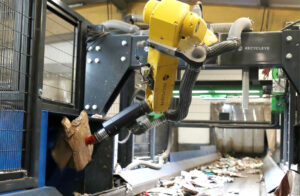 Following on from his explainer video, hear from Tom Alden on why the pneumatics system is at the heart of our solution.
Following on from his explainer video, hear from Tom Alden on why the pneumatics system is at the heart of our solution.
The pneumatics system of a waste picking robot is at the very heart of the solution. If the tubing is continuously blocked with items or the gripper is too fragile to withstand around-the-clock operation without failure, it is not fit for purpose.
Whereas, when the system is robust enough to deal with the challenges of picking mixed waste in dirty and challenging conditions, it can deliver on its promise of high levels of efficiency and consistent picking.
Recycleye Robotics has been developed with this in mind, which has enabled our solution to support Material Recovery Facilities across Europe to improve their waste-picking capabilities.
The first feature of Recycleye Robotics’ pneumatics system which sets it apart from its competition is the sheer robustness the gripper possesses, allowing it to operate in adverse conditions for long periods of time.
The Recycleye Robotics system functions with compressed air, which is used to suck the target material to pick it from the waste stream, before blowing the item into the correct waste bin, enabling the waste robot to sort the materials into their different classes.
The silicon gripper, or suction cup – which the system uses to pick and shoot items on the belt – has been designed specifically for dry mixed recyclables, having been adapted following rigorous testing and product development.
The end adaptor has the ability to mold to the item being picked, regardless of its shape, to ensure it has a strong grip of the target object. The system can then remove each item it picks from the waste stream by shooting it with the compressed air to sort it into the correct bin.
Tried and tested in the challenging conditions of a MRF, the gripper is able to pick target materials from a waste stream even if they are dusty or partially overlapping each other.
Additionally, the durable silicon material used for the gripper means that, depending on the conditions, it can last for weeks. When a replacement is needed, the process of removing the old gripper and installing a new one takes a few minutes and can be done during plant down time.
Following client feedback, the gripper underwent a phase of evolution, which saw its material and shape being adapted, ultimately rendering Recycleye Robotics an even more robust solution for picking DMR.
The solution is built-for-purpose, with the robustness of the system having been cited by Bryson Recycling in our recent case study.

“The nozzle was adapted by Recycleye after our feedback and now it lasts much, much longer, normally one month with over 20k picks per day”- Jarek Stanislawek, Engineering Manager at Bryson Recycling.
The nature of the system also means that Recycleye Robotics’ effectiveness is arguably unparalleled in the AI waste robot space.
Given the ‘pick-rotate-shoot’ functionality that the 6-axis robot offers, it saves time on movements back and forth to the bin. Unlike the delta robot, which needs to move almost directly over a bin to drop an item, the 6-axis has a greatly reduced pick path and can essentially stay within a much smaller area to do the same job.
Finally, the tubing used for our pneumatics system is wide, and very flexible. This enables dust and small objects to pass all the way to the filter, preventing unnecessary clogging, which would otherwise stop the waste robot from functioning properly.
Additionally, as part of our subscription and warranty package, the system is provided with plenty of spare tubing and grippers, so that if ever they are needed, they are ready for deployment within minutes.
So, in summary, Recycleye Robotics has been developed with the conditions of a modern MRF in mind. The system has been built for the purpose of picking dry mixed recyclables, and we believe the robustness the robot possesses makes it the best solution for doing so.
 Following on from his
Following on from his